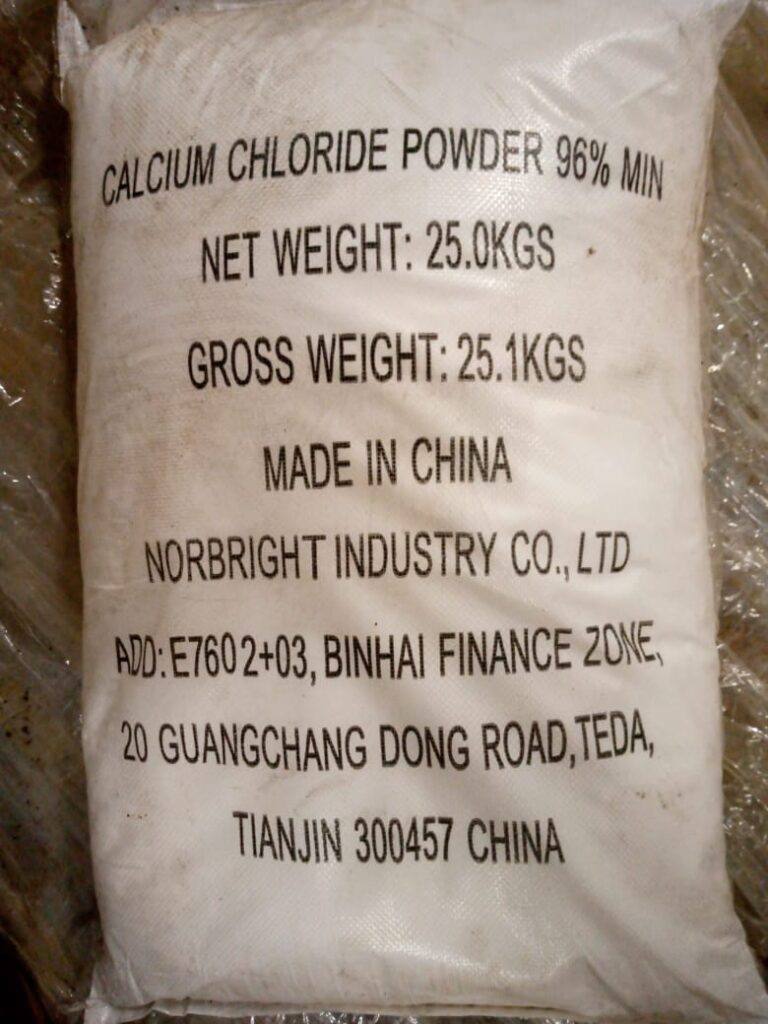
Calcium chloride (CaCl2) is a chemical compound that has various applications in different industries, including fish farming. In the context of fish farming, calcium chloride can be used for several purposes:
- Water quality management: Calcium chloride can be used to adjust the water hardness in fish farming ponds or tanks. Fish require specific water quality parameters to thrive, and maintaining proper water hardness levels is important for the health and growth of fish. Calcium chloride can be used to increase water hardness by adding calcium ions to the water.
- Disease prevention: Calcium chloride can help in preventing and treating certain diseases in fish. It can be used to disinfect water and equipment in fish farming facilities to reduce the risk of bacterial and fungal infections that can affect fish health. Calcium chloride can also help in maintaining optimal water quality conditions that are less conducive to disease outbreaks.
- Oxygenation: Calcium chloride can be used in combination with other chemicals to increase the dissolved oxygen levels in water. Adequate oxygen levels are crucial for the survival of fish, especially in densely stocked aquaculture systems. Calcium chloride can help improve oxygen solubility in water, which can benefit the overall health and growth of fish.
- pH regulation: Calcium chloride can be used to adjust and stabilize the pH of water in fish farming systems. Proper pH levels are important for the health and growth of fish, as extreme pH fluctuations can stress or harm the fish. Calcium chloride can help buffer the water and maintain a stable pH level, creating a more favorable environment for the fish.
- Molting in crustaceans: In aquaculture systems that include crustaceans such as shrimp and prawns, calcium chloride can be used to promote molting. Calcium is an essential mineral for the formation of the exoskeleton in crustaceans, and providing a source of calcium chloride can support the molting process and ensure healthy growth.
It is important to note that the use of calcium chloride in fish farming should be carefully managed to prevent overdosing and potential harm to the aquatic environment and fish. Proper dosage, monitoring of water quality parameters, and following recommended guidelines are essential to ensure the safe and effective use of calcium chloride in fish farming operations.
factors to consider to avoid overdosing in your pond
The proper dosage of calcium chloride in a fish pond will depend on various factors, including the size of the pond, the water quality parameters, the specific needs of the fish species being farmed, and the intended purpose of using calcium chloride. It is important to carefully calculate and monitor the dosage to avoid overdosing, which can have negative effects on the fish and the aquatic environment.
Here are some general guidelines for dosing calcium chloride in a fish pond:
- Water hardness adjustment: If the purpose of adding calcium chloride is to increase water hardness, the dosage will depend on the current hardness levels of the water and the desired target hardness. Water hardness is typically measured in terms of calcium carbonate equivalents (CaCO3). A common dosing range for water hardness adjustment is around 50-200 mg/L of calcium chloride, but this can vary based on specific requirements.
- pH regulation: When using calcium chloride for pH regulation, the dosage will depend on the initial pH of the water and the desired pH level. Calcium chloride can act as a buffer and help stabilize the pH of the water. Dosage recommendations for pH regulation can vary, but it is important to monitor the pH levels regularly and adjust the dosage accordingly.
- Disease prevention: If using calcium chloride for disease prevention by disinfecting water or equipment, dosage recommendations will depend on the specific application and the concentration needed for effective disinfection. It is important to follow recommended guidelines for disinfection to ensure that it is safe and effective for the fish.
- Oxygenation: Calcium chloride may be used in combination with other chemicals to increase dissolved oxygen levels in water. Dosage requirements for oxygenation purposes can vary based on the specific oxygenation system being used and the needs of the fish species in the pond.
It is recommended to consult with aquaculture experts, fishery professionals, or agricultural extension services to determine the appropriate dosage of calcium chloride for a specific fish pond based on its unique characteristics and requirements. Additionally, it is crucial to carefully monitor water quality parameters, fish behavior, and overall pond health when using calcium chloride or any other chemical in fish farming operations.
contact us for more chemical requirements for your production needs
Visit our website to buy more Chemicals tailored for your needs when you click here 👇
